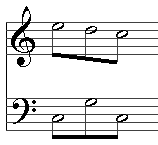
Linear progression
Encyclopedia

Music
Music is an art form whose medium is sound and silence. Its common elements are pitch , rhythm , dynamics, and the sonic qualities of timbre and texture...
, a linear progression (Zug, German: train, abbreviated: Zg.) is a passing note elaboration involving stepwise
Steps and skips
In music, a step, or conjunct motion, is a linear or successive interval between two pitches which are consecutive scale degrees. Any larger interval is called a skip , or disjunct motion...
melodic
Melody
A melody , also tune, voice, or line, is a linear succession of musical tones which is perceived as a single entity...
motion in one direction between two harmonic
Harmony
In music, harmony is the use of simultaneous pitches , or chords. The study of harmony involves chords and their construction and chord progressions and the principles of connection that govern them. Harmony is often said to refer to the "vertical" aspect of music, as distinguished from melodic...
tones. For example: -- over the tonic
Tonic (music)
In music, the tonic is the first scale degree of the diatonic scale and the tonal center or final resolution tone. The triad formed on the tonic note, the tonic chord, is thus the most significant chord...
. In German zug may be combined with prefixes to create related words such as untergreifzug (German: under-reaching linear progression), a linear progression rising from a lower voice, or terzzug (German: third linear progression), linear progression through a third
Third (chord)
In music, the third factor of a chord is the note or pitch two scale degrees above the root or tonal center. When the third is the bass note, or lowest note, of the expressed triad, the chord is in first inversion ....
. The term "zug" may best be translated as, "a direct, unimpeded motion from one place to another."
Linear progressions prolong
Prolongation
In music theory, prolongation refers to the process in tonal music through which a pitch, interval, or consonant triad is able to govern spans of music when not physically sounding...
harmonies and through elaboration, or filling-in with dissonant notes, of a leap between two consonant notes from different voices in a chord. In English they may be abbreviated "prg." such as 3-prg. for 'third progression' (rather than "zg.").
Note that the Mozart example above that the passing tones are dissonant and unable to be embellished, however, in the Urlinie example to the right the passing tone is supported harmonically, allowing for embellishment. Also note the Schenkerian notation indicating relative hierarchical depth, surface or structural importance, where structural notes are indicated through stems and beams and surface notes are indicated through note heads only which are then slurred to stemmed and beamed notes. Thus in the bottom right example the third progression from D is a decoration of the deeper third progression from E.

